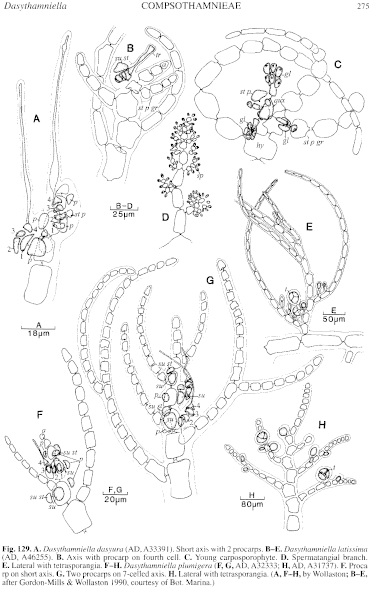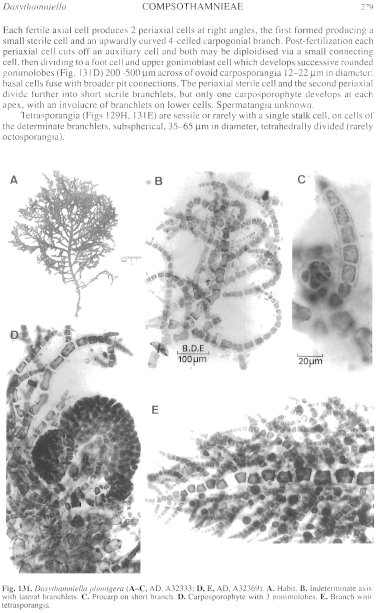|
|
|
|
|
|||||||||||
|
Electronic Flora of South Australia Species Fact Sheet
Phylum Rhodophyta – Order Ceramiales – Family Ceramiaceae – Tribe Compsothamnieae
Synonyms
Callithamnion plumigerum Harvey 1863: pl. 285, synop. : li. J. Agardh 1876: 49. Sonder 1881: 10.
Spongoclonium plumigerum (Harvey) J. Agardh 1894a: 118.
Lasiothalia plumigera (Harvey) De Toni 1903: 1420. Lucas 1909: 52.
Thallus (Fig. 131A) medium to dark red-brown, 5–25 cm high, alternately distichously and complanately branched for 4–5 orders, usually with a single main axis 2–3 mm in diameter; branches terete, 0.5–1 mm in diameter above, becoming heavily corticated and densely covered with branchlets. Holdfast conical, rhizoidal, 2–5 mm across; epilithic. Structure. Apices (Fig. 131B, E) of indeterminate branches with short apical and subapical cells 10–18 µm in diameter and L/D 0.8–1.2, with oblique divisions and alternate distichous branchlets, emergent, axial cells increasing to 30–50 µm in diameter and L/D 1–1.4 some 10–20 cells below the apices and to 300–500 µm in diameter and L/D (1–) 2–4 (–6) in lower thallus. Cortication of axes and lateral branches commences close to the apices, by rhizoids from the basal cells of laterals, becoming dense and with the outer cells producing short, branched, anticlinal filaments 350–500 µm long and 20–30 µm in diameter, cells L/D 1–1.5. Lateral branches developing by branchlets becoming indeterminate. Determinate branchlets 500–900 µm long, covering most branches, at first distichously branched but their secondary branches often at other angles, with curved unbranched ends 100–200 µm and 10–15 cells long when mature, cells 30–40 µm in diameter basally and L/D 0.8–1, tapering slightly to 15–20 µm in subapical cells. Cells multinucleate; rhodoplasts discoid, elongate in larger cells.
Reproduction: Gametophytes probably dioecious. Procarps (Figs 129F, G, 131C) borne on axial cells near branch apices, often on 2–3 (–4) successive cells with the first procarp on a cell 2–4 cells below the apex and a further 1–3 cells bearing procarps as the axis elongates.
Lectotype from Western Port, Vic. (Harvey); in Herb. Harvey, TCD (Alg. Aust. Exsicc. 507H). Harvey in his protologue also recorded the species from Cape Liptrap, Port Fairy and Cape Shank, all in Victoria. The lectotype is very similar in form (reversed) to Harvey's Pl. 285, fig. 1.
Selected specimens: Toad Head, West I., S. Aust., 18 m deep (Shepherd, 24.x.1966; AD, A31572). Bridgewater Bay, Vic., drift (Beauglehole, 26.xii.1950; AD, A15654). Lady Julia Percy I., Vic., 8–13 m and 8–12 m deep (Shepherd, 5.i.1968; AD, A32333 and 3.i.1968; AD, A32463 resp.). Port Fairy, Vic., drift (Womersley, 25.i.1967; AD, A31737). Warrnambool, Vic., drift (Kraft 8096 & Herrington, 19.xi.1989; MELU and AD, A67833). Cape Woolamai, Vic., 15–18 m deep (Goldsworthy & Berthold, 16.ii.1990; AD, A60207). Granville Harbour, W Tas., 3–10 m deep (Blackman 79–31,28.i.1979; AD, A58559). Fluted Cape, Bruny I., Tas., 10 m deep (Shepherd, 12.ii.1972; AD, A41999). Recherche Bay, D'Entrecasteaux Ch., Tas., 10 m deep (AIMS/NCI Q66C, 5078-L, 14.ii.1991; AD, A61380).
Distribution: West I., Victor Harbor, S. Aust., to Cape Liptrap (Harvey), Vic., and SE Tasmania.
Taxonomic notes: Each fertile axial cell produces 2 periaxial cells at right angles, the first formed producing a small sterile cell and an upwardly curved 4-celled carpogonial branch. Post-fertilization each periaxial cell cuts off an auxiliary cell and both may be diploidised via a small connecting cell, then dividing to a foot cell and upper gonimoblast cell which develops successive rounded gonimolobes (Fig. 131D) 200–500 µm across of ovoid carposporangia 12–22 µm in diameter; basal cells fuse with broader pit connections. The periaxial sterile cell and the second periaxial divide further into short sterile branchlets, but only one carposporophyte develops at each apex, with an involucre of branchlets on lower cells. Spermatangia unknown.
Tetrasporangia (Figs 129H, 131E) are sessile or rarely with a single stalk cell, on cells of the determinate branchlets, subspherical, 35–65 µm in diameter, tetrahedrally divided (rarely octosporangia).
References:
AGARDH, J.G. (1876). Species Genera et Ordines Algarum. Vol. 3, Part 1- Epicrisis systematic Floridearum, pp. i-vii, 1–724. (Weigel: Leipzig.)
AGARDH, J.G. (1894a). Analecta Algologica. Cont. I. Acta Univ. lund. 29, 1–144, Plates 1, 2.
DE TONI, G.B. (1903). Sylloge Algarum omnium hucusque Cognitarum. Vol. 4. Florideae. Sect. 3, pp. 775–1521 + 1523–1525. (Padua.)
HARVEY, W.H. (1863). Phycologia Australica. Vol. 5, Plates 241–300, synop., pp. i-lxxiii. (Reeve: London.)
LUCAS, A.H.S. (1909). Revised list of the Fucoideae and Florideae of Australia. Proc. Linn. Soc. N.S.W. 34, 9–60.
SONDER, O.W. (1881). In Mueller, F., Fragmenta Phytographiae Australiae. Supplementum ad volumen undecinum: Algae Australianae hactenus cognitae, pp. 1–42, 105–107. (Melbourne.)
The Marine Benthic Flora of Southern Australia Part IIIC complete list of references.
Publication:
Womersley, H.B.S. (24 December, 1998)
The Marine Benthic Flora of Southern Australia
Rhodophyta. Part IIIC. Ceramiales – Ceramiaceae, Dasyaceae
©State Herbarium of South Australia, Government of South Australia
Illustrations in Womersley Part IIIA, 1998: FIGS 129 F–H, 131.

Figure 129 enlarge
Fig. 129. A. Dasythamniella dasyura (AD, A33391). Short axis with 2 procarps. B–E. Dasythamniella latissima (AD, A46255). B. Axis with procarp on fourth cell. C. Young carposporophyte. D. Spermatangial branch. E. Lateral with tetrasporangia. F–H. Dasythamniella plumigera (F, G, AD, A32333; H, AD, A31737). F. Procarp on short axis. G. Two procarps on 7-celled axis. H. Lateral with tetrasporangia. (A, F–H, by Wollaston; B–E, after Gordon-Mills & Wollaston 1990, courtesy of Bot. Marina.)

Figure 131 enlarge
Fig. 131. Dasythamniella plumigera (A–C, AD, A32333; D, E, AD, A32369). A. Habit. B. Indeterminate axis with lateral branchlets. C. Procarp on short branch. D. Carposporophyte with 3 gonimolobes. E. Branch with tetrasporangia.

|
Email Contact: State Herbarium of South Australia |

|